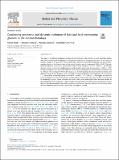Files in this item
Contrasting geometric and dynamic evolution of lake and land-terminating glaciers in the central Himalaya
Item metadata
| dc.contributor.author | King, Owen | |
| dc.contributor.author | Dehecq, Amaury | |
| dc.contributor.author | Quincey, Duncan | |
| dc.contributor.author | Carrivick, Jonathan | |
| dc.date.accessioned | 2019-11-26T15:30:08Z | |
| dc.date.available | 2019-11-26T15:30:08Z | |
| dc.date.issued | 2018-08 | |
| dc.identifier | 263617017 | |
| dc.identifier | 41b35077-31e4-4ccd-b48f-1a210831f22b | |
| dc.identifier | 85047603512 | |
| dc.identifier.citation | King , O , Dehecq , A , Quincey , D & Carrivick , J 2018 , ' Contrasting geometric and dynamic evolution of lake and land-terminating glaciers in the central Himalaya ' , Global and Planetary Change , vol. 167 , pp. 46-60 . https://doi.org/10.1016/j.gloplacha.2018.05.006 | en |
| dc.identifier.issn | 0921-8181 | |
| dc.identifier.uri | https://hdl.handle.net/10023/19007 | |
| dc.description | OK is a recipient of a NERC SPHERES DTP PhD Studentship (grant award NE/L002574/1). AD was supported by funding from the NASA Cryosphere Program. The research was conducted at the Jet Propulsion Laboratory, California Institute of Technology under contract with the National Aeronautics and Space Agency. | en |
| dc.description.abstract | The impact of glacial lake development on the evolution of glaciers in the Himalaya is poorly quantified, despite the increasing prevalence of supraglacial and proglacial water bodies throughout the region. In this study we examine changes in the geometry, velocity and surface elevation of nine lake-terminating and nine land-terminating glaciers in the Everest region of the central Himalaya over the time period 2000 to 2015. The land-terminating glaciers we examined all decelerated (mean velocity change of −0.16 to −5.60 m a −1 for different glaciers), thinned most in their middle reaches, and developed a more gently sloping surface (−0.02 to −0.37° change) down-glacier over the period 2000–2015. The lake-terminating glaciers we examined all retreated (0.46 to 1.42 km), became steeper (0.04 to 8.68° change), and showed maximum thinning towards their termini, but differed in terms of their dynamics, with one group of glaciers accelerating (mean speed-up of 0.18 to 8.04 m a −1 ) and the other decelerating (mean slow-down of −0.36 m a −1 to −8.68 m a −1 ). We suggest that these two scenarios of glacier evolution each represent a different phase of glacial lake expansion; one that is accompanied by increasingly dynamic glacier behaviour and retreat, and a phase where glacial lakes have little impact on glacier behaviour that may precede or follow the phase of active retreat. Our observations are important because they quantify the interaction of glacial lake expansion with glacier ice mass loss, and show that increased glacier recession should be expected where a glacial lake has begun to develop. | |
| dc.format.extent | 15 | |
| dc.format.extent | 5490671 | |
| dc.language.iso | eng | |
| dc.relation.ispartof | Global and Planetary Change | en |
| dc.subject | Digital elevation model | en |
| dc.subject | Glacial lake outburst floods | en |
| dc.subject | Glacial lakes | en |
| dc.subject | Glacier velocity | en |
| dc.subject | Himalaya | en |
| dc.subject | G Geography (General) | en |
| dc.subject | Oceanography | en |
| dc.subject | Global and Planetary Change | en |
| dc.subject | DAS | en |
| dc.subject.lcc | G1 | en |
| dc.title | Contrasting geometric and dynamic evolution of lake and land-terminating glaciers in the central Himalaya | en |
| dc.type | Journal article | en |
| dc.contributor.institution | University of St Andrews. School of Geography & Sustainable Development | en |
| dc.identifier.doi | https://doi.org/10.1016/j.gloplacha.2018.05.006 | |
| dc.description.status | Peer reviewed | en |
This item appears in the following Collection(s)
Items in the St Andrews Research Repository are protected by copyright, with all rights reserved, unless otherwise indicated.

